Cultural Considerations for Business in Japan: An Essay
VerifiedAdded on 2023/01/18
|7
|1907
|88
Essay
AI Summary
This essay examines the crucial role of culture in international business, specifically focusing on the Japanese market. The essay uses a case study of Mary, a food manufacturer aiming to expand into Japan. It details essential aspects of Japanese business etiquette, including bowing, seating protocols, business card exchange, punctuality, conversation, body language, and gift-giving. The essay also incorporates Hofstede's cultural dimensions to analyze Japanese culture, emphasizing high power distance, collectivism, masculinity, uncertainty avoidance, and long-term orientation. It concludes with actionable strategies for Mary to enhance her chances of a successful business meeting with Mr. Moro, highlighting the importance of preparation, formality, and cultural sensitivity to achieve favorable outcomes and establish strong business relationships in Japan.
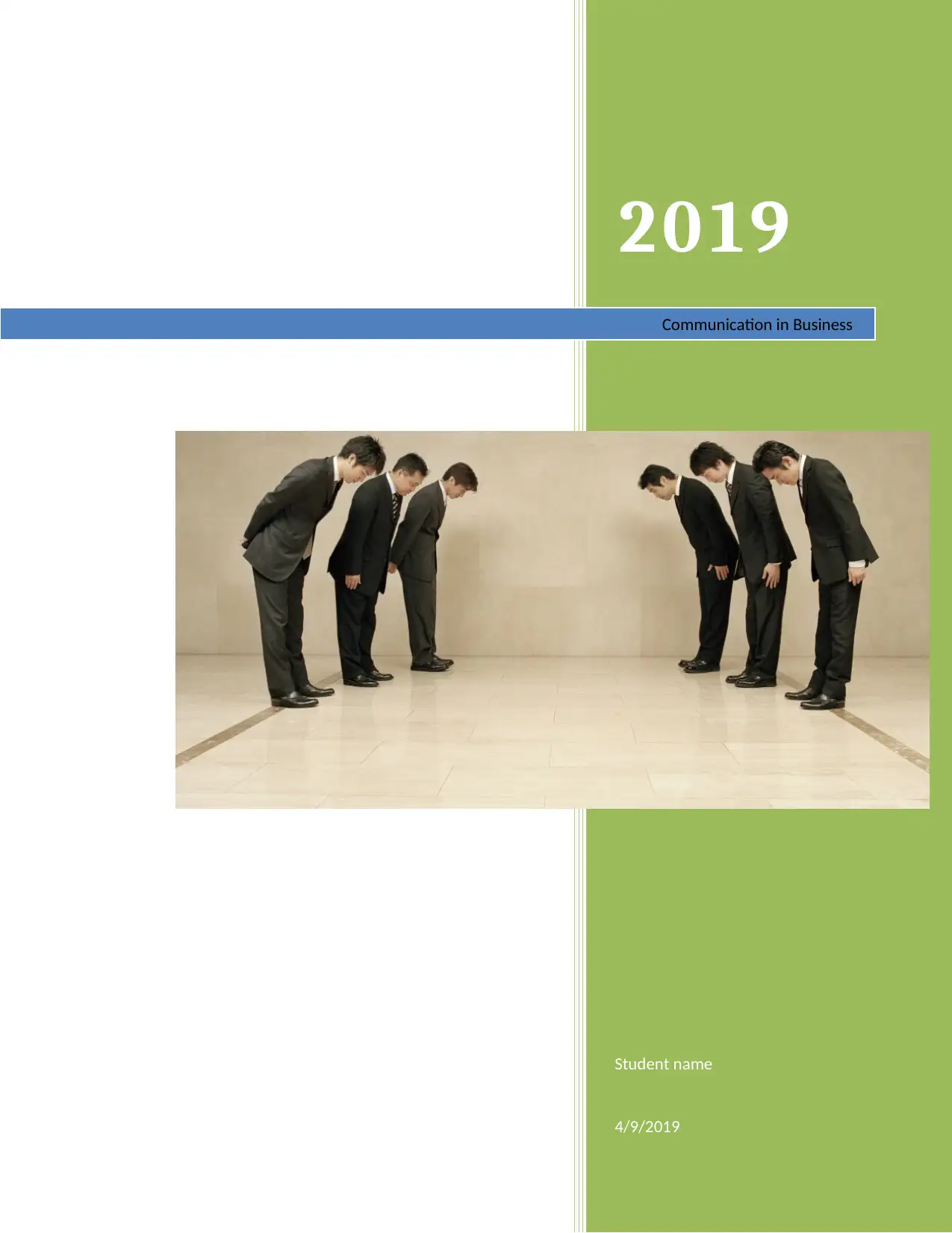
2019
Student name
4/9/2019
Communication in Business
Student name
4/9/2019
Communication in Business
Paraphrase This Document
Need a fresh take? Get an instant paraphrase of this document with our AI Paraphraser
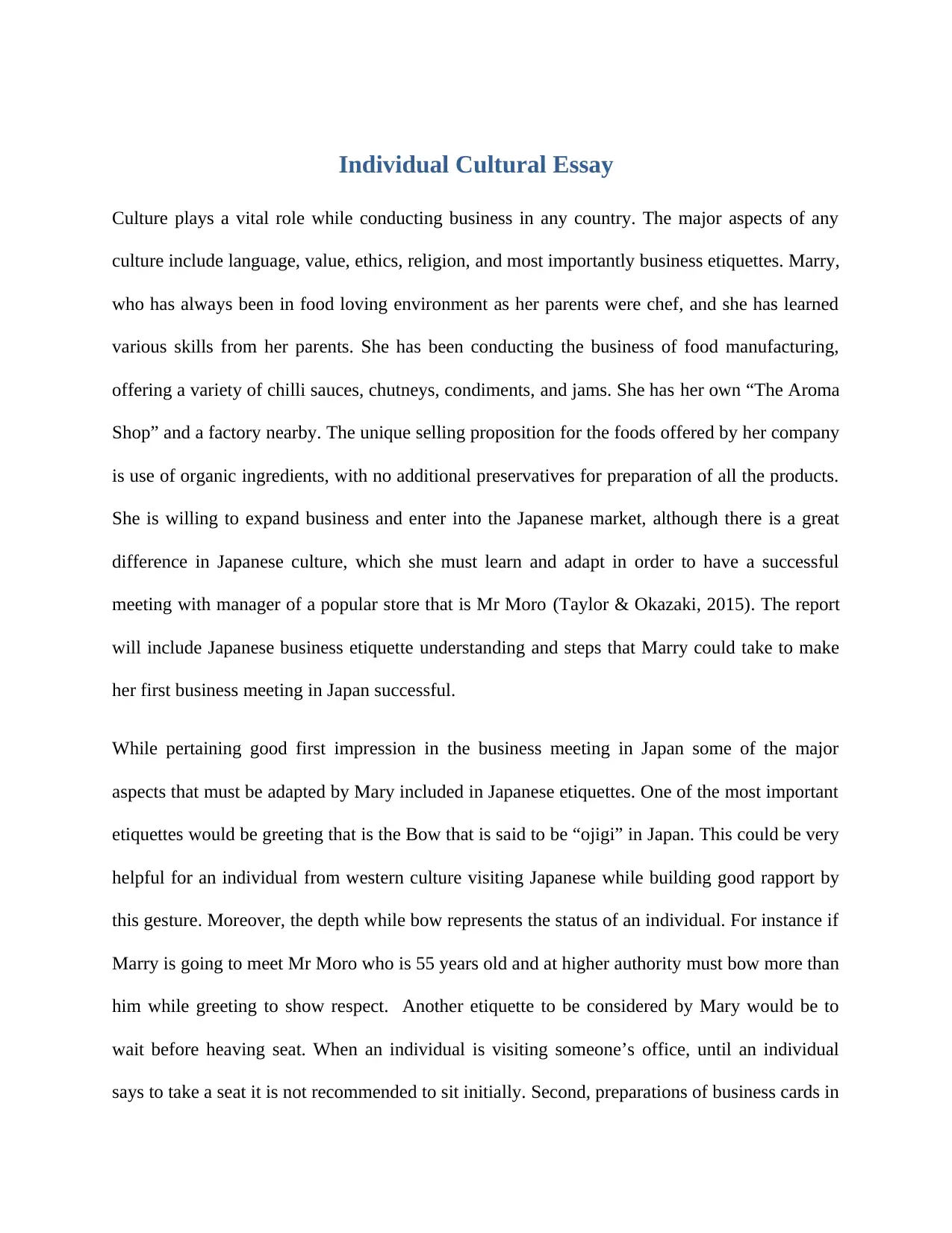
Individual Cultural Essay
Culture plays a vital role while conducting business in any country. The major aspects of any
culture include language, value, ethics, religion, and most importantly business etiquettes. Marry,
who has always been in food loving environment as her parents were chef, and she has learned
various skills from her parents. She has been conducting the business of food manufacturing,
offering a variety of chilli sauces, chutneys, condiments, and jams. She has her own “The Aroma
Shop” and a factory nearby. The unique selling proposition for the foods offered by her company
is use of organic ingredients, with no additional preservatives for preparation of all the products.
She is willing to expand business and enter into the Japanese market, although there is a great
difference in Japanese culture, which she must learn and adapt in order to have a successful
meeting with manager of a popular store that is Mr Moro (Taylor & Okazaki, 2015). The report
will include Japanese business etiquette understanding and steps that Marry could take to make
her first business meeting in Japan successful.
While pertaining good first impression in the business meeting in Japan some of the major
aspects that must be adapted by Mary included in Japanese etiquettes. One of the most important
etiquettes would be greeting that is the Bow that is said to be “ojigi” in Japan. This could be very
helpful for an individual from western culture visiting Japanese while building good rapport by
this gesture. Moreover, the depth while bow represents the status of an individual. For instance if
Marry is going to meet Mr Moro who is 55 years old and at higher authority must bow more than
him while greeting to show respect. Another etiquette to be considered by Mary would be to
wait before heaving seat. When an individual is visiting someone’s office, until an individual
says to take a seat it is not recommended to sit initially. Second, preparations of business cards in
Culture plays a vital role while conducting business in any country. The major aspects of any
culture include language, value, ethics, religion, and most importantly business etiquettes. Marry,
who has always been in food loving environment as her parents were chef, and she has learned
various skills from her parents. She has been conducting the business of food manufacturing,
offering a variety of chilli sauces, chutneys, condiments, and jams. She has her own “The Aroma
Shop” and a factory nearby. The unique selling proposition for the foods offered by her company
is use of organic ingredients, with no additional preservatives for preparation of all the products.
She is willing to expand business and enter into the Japanese market, although there is a great
difference in Japanese culture, which she must learn and adapt in order to have a successful
meeting with manager of a popular store that is Mr Moro (Taylor & Okazaki, 2015). The report
will include Japanese business etiquette understanding and steps that Marry could take to make
her first business meeting in Japan successful.
While pertaining good first impression in the business meeting in Japan some of the major
aspects that must be adapted by Mary included in Japanese etiquettes. One of the most important
etiquettes would be greeting that is the Bow that is said to be “ojigi” in Japan. This could be very
helpful for an individual from western culture visiting Japanese while building good rapport by
this gesture. Moreover, the depth while bow represents the status of an individual. For instance if
Marry is going to meet Mr Moro who is 55 years old and at higher authority must bow more than
him while greeting to show respect. Another etiquette to be considered by Mary would be to
wait before heaving seat. When an individual is visiting someone’s office, until an individual
says to take a seat it is not recommended to sit initially. Second, preparations of business cards in
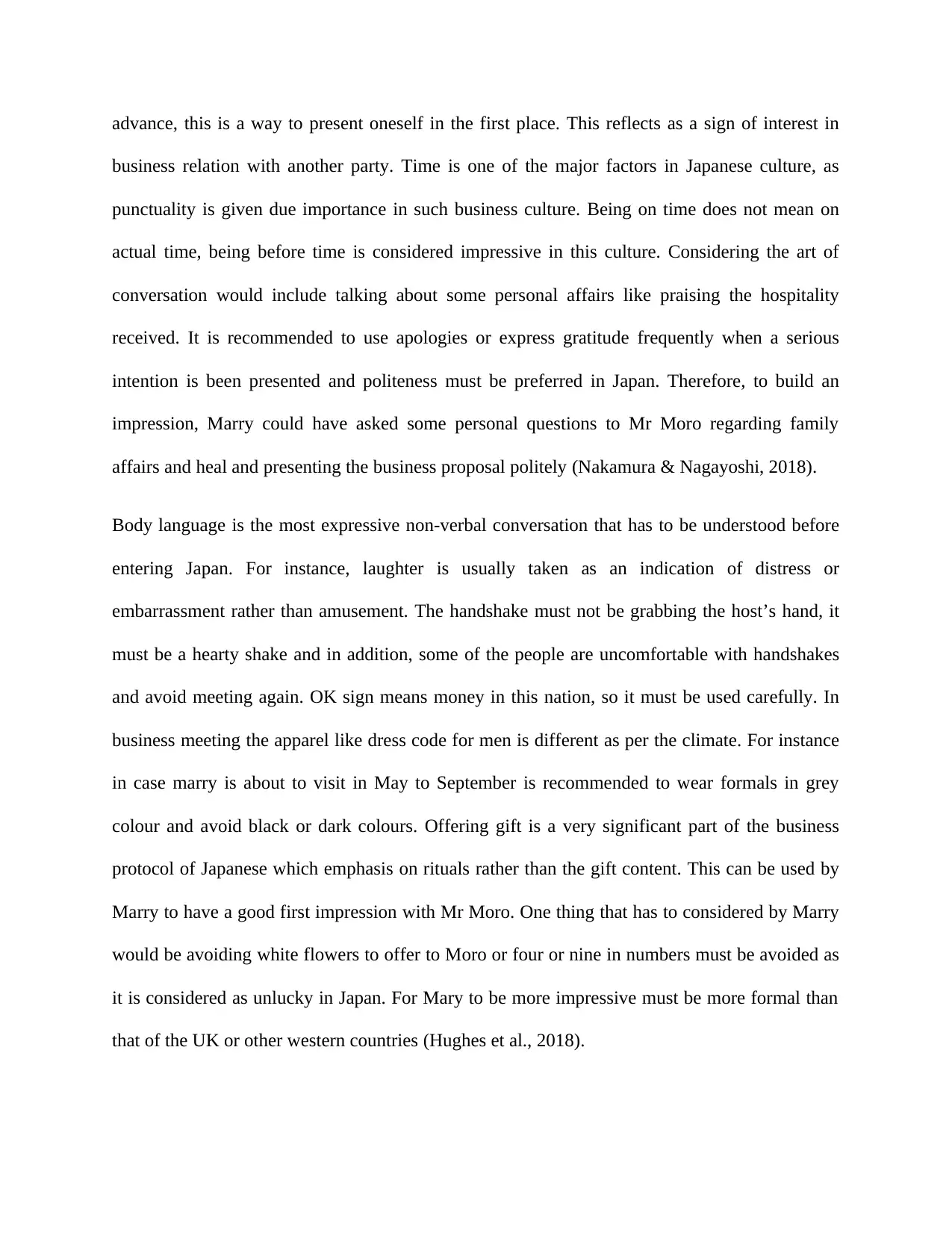
advance, this is a way to present oneself in the first place. This reflects as a sign of interest in
business relation with another party. Time is one of the major factors in Japanese culture, as
punctuality is given due importance in such business culture. Being on time does not mean on
actual time, being before time is considered impressive in this culture. Considering the art of
conversation would include talking about some personal affairs like praising the hospitality
received. It is recommended to use apologies or express gratitude frequently when a serious
intention is been presented and politeness must be preferred in Japan. Therefore, to build an
impression, Marry could have asked some personal questions to Mr Moro regarding family
affairs and heal and presenting the business proposal politely (Nakamura & Nagayoshi, 2018).
Body language is the most expressive non-verbal conversation that has to be understood before
entering Japan. For instance, laughter is usually taken as an indication of distress or
embarrassment rather than amusement. The handshake must not be grabbing the host’s hand, it
must be a hearty shake and in addition, some of the people are uncomfortable with handshakes
and avoid meeting again. OK sign means money in this nation, so it must be used carefully. In
business meeting the apparel like dress code for men is different as per the climate. For instance
in case marry is about to visit in May to September is recommended to wear formals in grey
colour and avoid black or dark colours. Offering gift is a very significant part of the business
protocol of Japanese which emphasis on rituals rather than the gift content. This can be used by
Marry to have a good first impression with Mr Moro. One thing that has to considered by Marry
would be avoiding white flowers to offer to Moro or four or nine in numbers must be avoided as
it is considered as unlucky in Japan. For Mary to be more impressive must be more formal than
that of the UK or other western countries (Hughes et al., 2018).
business relation with another party. Time is one of the major factors in Japanese culture, as
punctuality is given due importance in such business culture. Being on time does not mean on
actual time, being before time is considered impressive in this culture. Considering the art of
conversation would include talking about some personal affairs like praising the hospitality
received. It is recommended to use apologies or express gratitude frequently when a serious
intention is been presented and politeness must be preferred in Japan. Therefore, to build an
impression, Marry could have asked some personal questions to Mr Moro regarding family
affairs and heal and presenting the business proposal politely (Nakamura & Nagayoshi, 2018).
Body language is the most expressive non-verbal conversation that has to be understood before
entering Japan. For instance, laughter is usually taken as an indication of distress or
embarrassment rather than amusement. The handshake must not be grabbing the host’s hand, it
must be a hearty shake and in addition, some of the people are uncomfortable with handshakes
and avoid meeting again. OK sign means money in this nation, so it must be used carefully. In
business meeting the apparel like dress code for men is different as per the climate. For instance
in case marry is about to visit in May to September is recommended to wear formals in grey
colour and avoid black or dark colours. Offering gift is a very significant part of the business
protocol of Japanese which emphasis on rituals rather than the gift content. This can be used by
Marry to have a good first impression with Mr Moro. One thing that has to considered by Marry
would be avoiding white flowers to offer to Moro or four or nine in numbers must be avoided as
it is considered as unlucky in Japan. For Mary to be more impressive must be more formal than
that of the UK or other western countries (Hughes et al., 2018).
⊘ This is a preview!⊘
Do you want full access?
Subscribe today to unlock all pages.

Trusted by 1+ million students worldwide
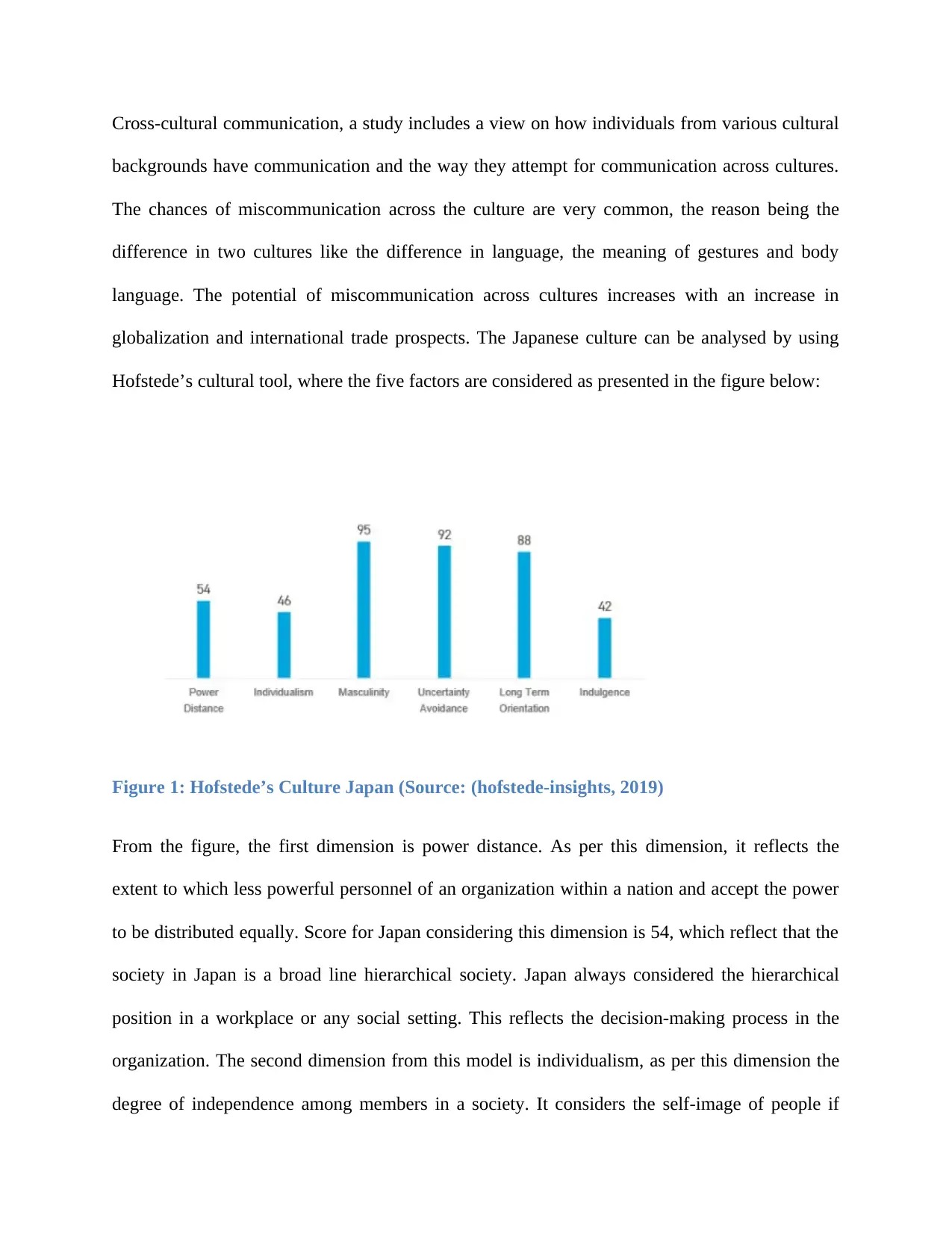
Cross-cultural communication, a study includes a view on how individuals from various cultural
backgrounds have communication and the way they attempt for communication across cultures.
The chances of miscommunication across the culture are very common, the reason being the
difference in two cultures like the difference in language, the meaning of gestures and body
language. The potential of miscommunication across cultures increases with an increase in
globalization and international trade prospects. The Japanese culture can be analysed by using
Hofstede’s cultural tool, where the five factors are considered as presented in the figure below:
Figure 1: Hofstede’s Culture Japan (Source: (hofstede-insights, 2019)
From the figure, the first dimension is power distance. As per this dimension, it reflects the
extent to which less powerful personnel of an organization within a nation and accept the power
to be distributed equally. Score for Japan considering this dimension is 54, which reflect that the
society in Japan is a broad line hierarchical society. Japan always considered the hierarchical
position in a workplace or any social setting. This reflects the decision-making process in the
organization. The second dimension from this model is individualism, as per this dimension the
degree of independence among members in a society. It considers the self-image of people if
backgrounds have communication and the way they attempt for communication across cultures.
The chances of miscommunication across the culture are very common, the reason being the
difference in two cultures like the difference in language, the meaning of gestures and body
language. The potential of miscommunication across cultures increases with an increase in
globalization and international trade prospects. The Japanese culture can be analysed by using
Hofstede’s cultural tool, where the five factors are considered as presented in the figure below:
Figure 1: Hofstede’s Culture Japan (Source: (hofstede-insights, 2019)
From the figure, the first dimension is power distance. As per this dimension, it reflects the
extent to which less powerful personnel of an organization within a nation and accept the power
to be distributed equally. Score for Japan considering this dimension is 54, which reflect that the
society in Japan is a broad line hierarchical society. Japan always considered the hierarchical
position in a workplace or any social setting. This reflects the decision-making process in the
organization. The second dimension from this model is individualism, as per this dimension the
degree of independence among members in a society. It considers the self-image of people if
Paraphrase This Document
Need a fresh take? Get an instant paraphrase of this document with our AI Paraphraser
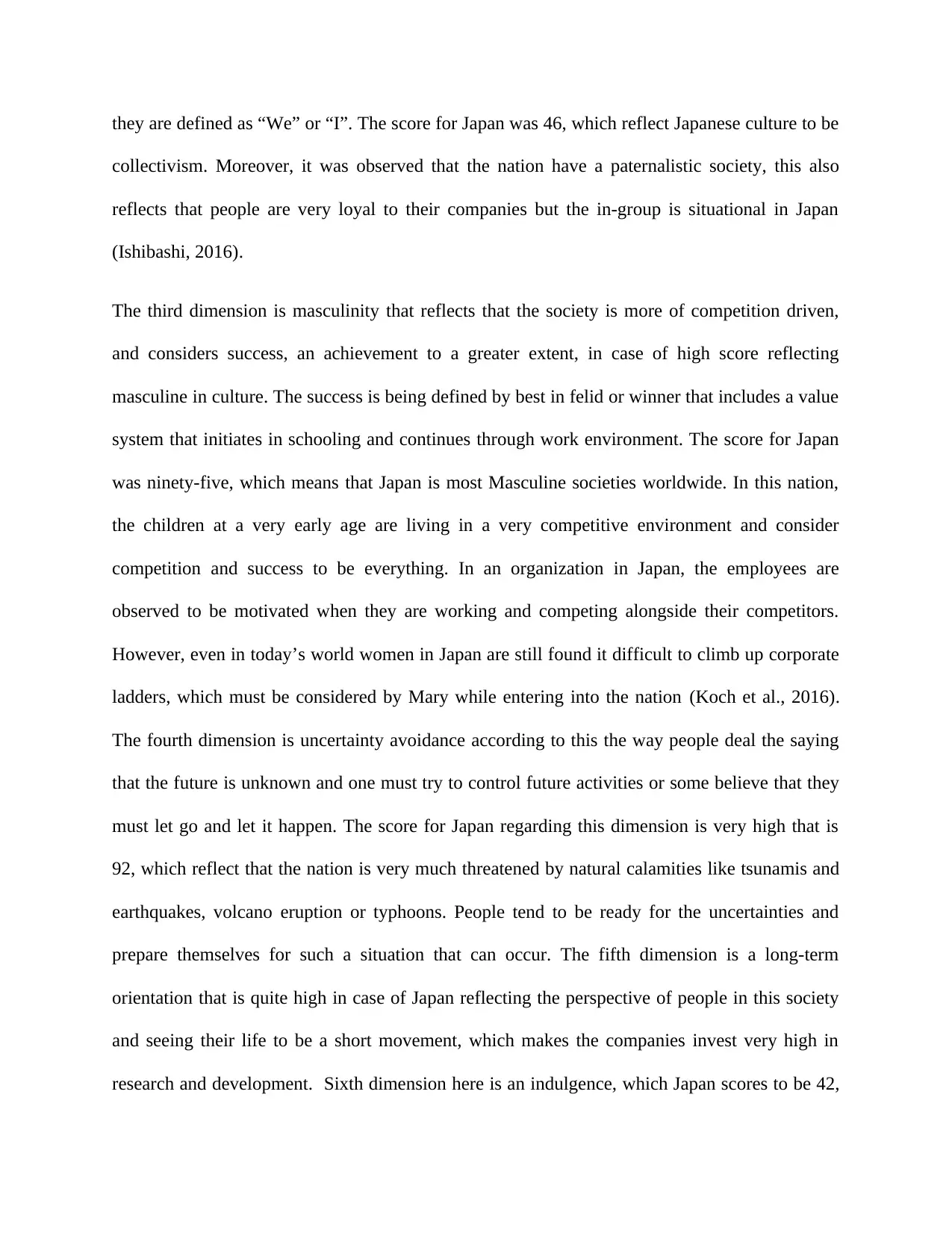
they are defined as “We” or “I”. The score for Japan was 46, which reflect Japanese culture to be
collectivism. Moreover, it was observed that the nation have a paternalistic society, this also
reflects that people are very loyal to their companies but the in-group is situational in Japan
(Ishibashi, 2016).
The third dimension is masculinity that reflects that the society is more of competition driven,
and considers success, an achievement to a greater extent, in case of high score reflecting
masculine in culture. The success is being defined by best in felid or winner that includes a value
system that initiates in schooling and continues through work environment. The score for Japan
was ninety-five, which means that Japan is most Masculine societies worldwide. In this nation,
the children at a very early age are living in a very competitive environment and consider
competition and success to be everything. In an organization in Japan, the employees are
observed to be motivated when they are working and competing alongside their competitors.
However, even in today’s world women in Japan are still found it difficult to climb up corporate
ladders, which must be considered by Mary while entering into the nation (Koch et al., 2016).
The fourth dimension is uncertainty avoidance according to this the way people deal the saying
that the future is unknown and one must try to control future activities or some believe that they
must let go and let it happen. The score for Japan regarding this dimension is very high that is
92, which reflect that the nation is very much threatened by natural calamities like tsunamis and
earthquakes, volcano eruption or typhoons. People tend to be ready for the uncertainties and
prepare themselves for such a situation that can occur. The fifth dimension is a long-term
orientation that is quite high in case of Japan reflecting the perspective of people in this society
and seeing their life to be a short movement, which makes the companies invest very high in
research and development. Sixth dimension here is an indulgence, which Japan scores to be 42,
collectivism. Moreover, it was observed that the nation have a paternalistic society, this also
reflects that people are very loyal to their companies but the in-group is situational in Japan
(Ishibashi, 2016).
The third dimension is masculinity that reflects that the society is more of competition driven,
and considers success, an achievement to a greater extent, in case of high score reflecting
masculine in culture. The success is being defined by best in felid or winner that includes a value
system that initiates in schooling and continues through work environment. The score for Japan
was ninety-five, which means that Japan is most Masculine societies worldwide. In this nation,
the children at a very early age are living in a very competitive environment and consider
competition and success to be everything. In an organization in Japan, the employees are
observed to be motivated when they are working and competing alongside their competitors.
However, even in today’s world women in Japan are still found it difficult to climb up corporate
ladders, which must be considered by Mary while entering into the nation (Koch et al., 2016).
The fourth dimension is uncertainty avoidance according to this the way people deal the saying
that the future is unknown and one must try to control future activities or some believe that they
must let go and let it happen. The score for Japan regarding this dimension is very high that is
92, which reflect that the nation is very much threatened by natural calamities like tsunamis and
earthquakes, volcano eruption or typhoons. People tend to be ready for the uncertainties and
prepare themselves for such a situation that can occur. The fifth dimension is a long-term
orientation that is quite high in case of Japan reflecting the perspective of people in this society
and seeing their life to be a short movement, which makes the companies invest very high in
research and development. Sixth dimension here is an indulgence, which Japan scores to be 42,
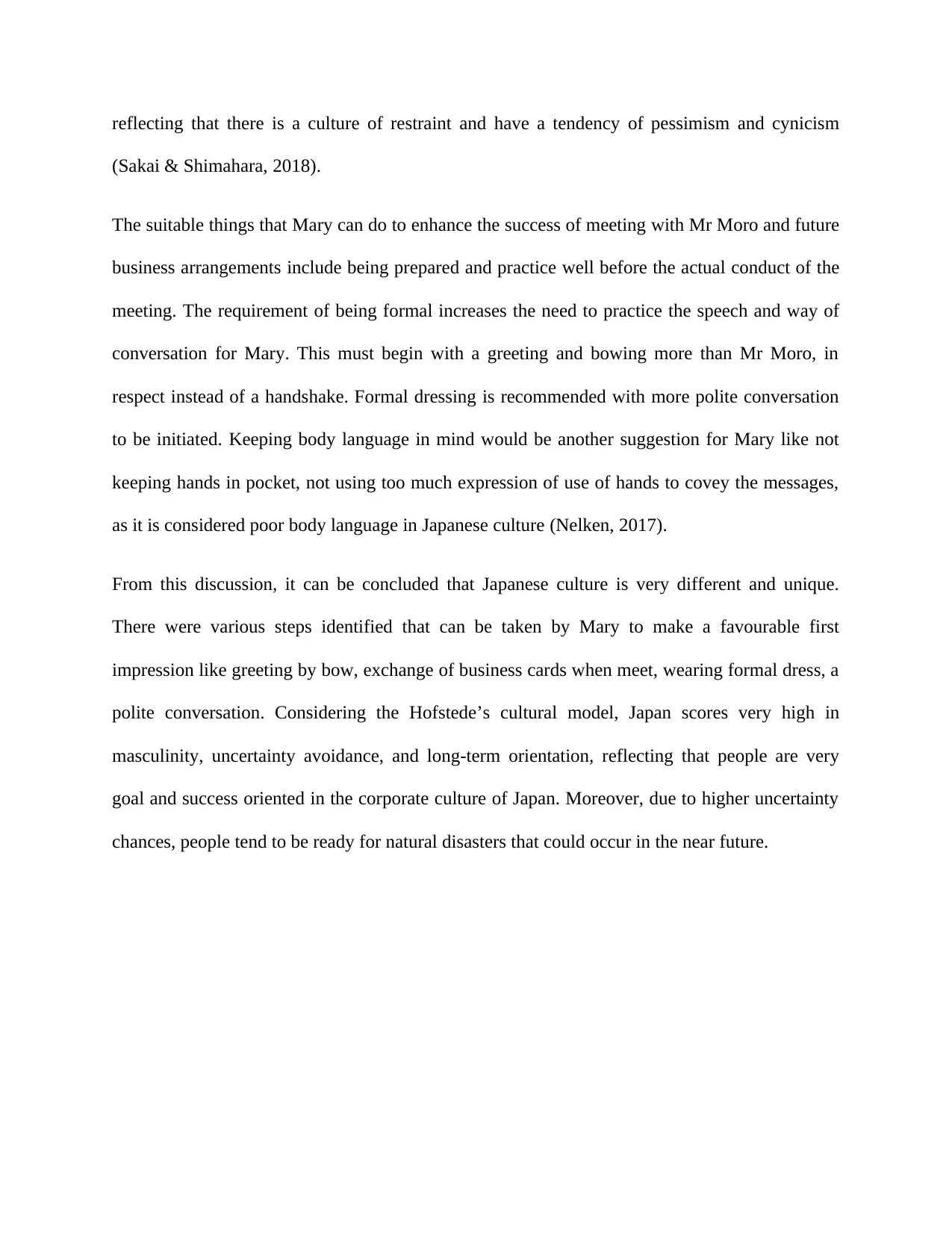
reflecting that there is a culture of restraint and have a tendency of pessimism and cynicism
(Sakai & Shimahara, 2018).
The suitable things that Mary can do to enhance the success of meeting with Mr Moro and future
business arrangements include being prepared and practice well before the actual conduct of the
meeting. The requirement of being formal increases the need to practice the speech and way of
conversation for Mary. This must begin with a greeting and bowing more than Mr Moro, in
respect instead of a handshake. Formal dressing is recommended with more polite conversation
to be initiated. Keeping body language in mind would be another suggestion for Mary like not
keeping hands in pocket, not using too much expression of use of hands to covey the messages,
as it is considered poor body language in Japanese culture (Nelken, 2017).
From this discussion, it can be concluded that Japanese culture is very different and unique.
There were various steps identified that can be taken by Mary to make a favourable first
impression like greeting by bow, exchange of business cards when meet, wearing formal dress, a
polite conversation. Considering the Hofstede’s cultural model, Japan scores very high in
masculinity, uncertainty avoidance, and long-term orientation, reflecting that people are very
goal and success oriented in the corporate culture of Japan. Moreover, due to higher uncertainty
chances, people tend to be ready for natural disasters that could occur in the near future.
(Sakai & Shimahara, 2018).
The suitable things that Mary can do to enhance the success of meeting with Mr Moro and future
business arrangements include being prepared and practice well before the actual conduct of the
meeting. The requirement of being formal increases the need to practice the speech and way of
conversation for Mary. This must begin with a greeting and bowing more than Mr Moro, in
respect instead of a handshake. Formal dressing is recommended with more polite conversation
to be initiated. Keeping body language in mind would be another suggestion for Mary like not
keeping hands in pocket, not using too much expression of use of hands to covey the messages,
as it is considered poor body language in Japanese culture (Nelken, 2017).
From this discussion, it can be concluded that Japanese culture is very different and unique.
There were various steps identified that can be taken by Mary to make a favourable first
impression like greeting by bow, exchange of business cards when meet, wearing formal dress, a
polite conversation. Considering the Hofstede’s cultural model, Japan scores very high in
masculinity, uncertainty avoidance, and long-term orientation, reflecting that people are very
goal and success oriented in the corporate culture of Japan. Moreover, due to higher uncertainty
chances, people tend to be ready for natural disasters that could occur in the near future.
⊘ This is a preview!⊘
Do you want full access?
Subscribe today to unlock all pages.

Trusted by 1+ million students worldwide
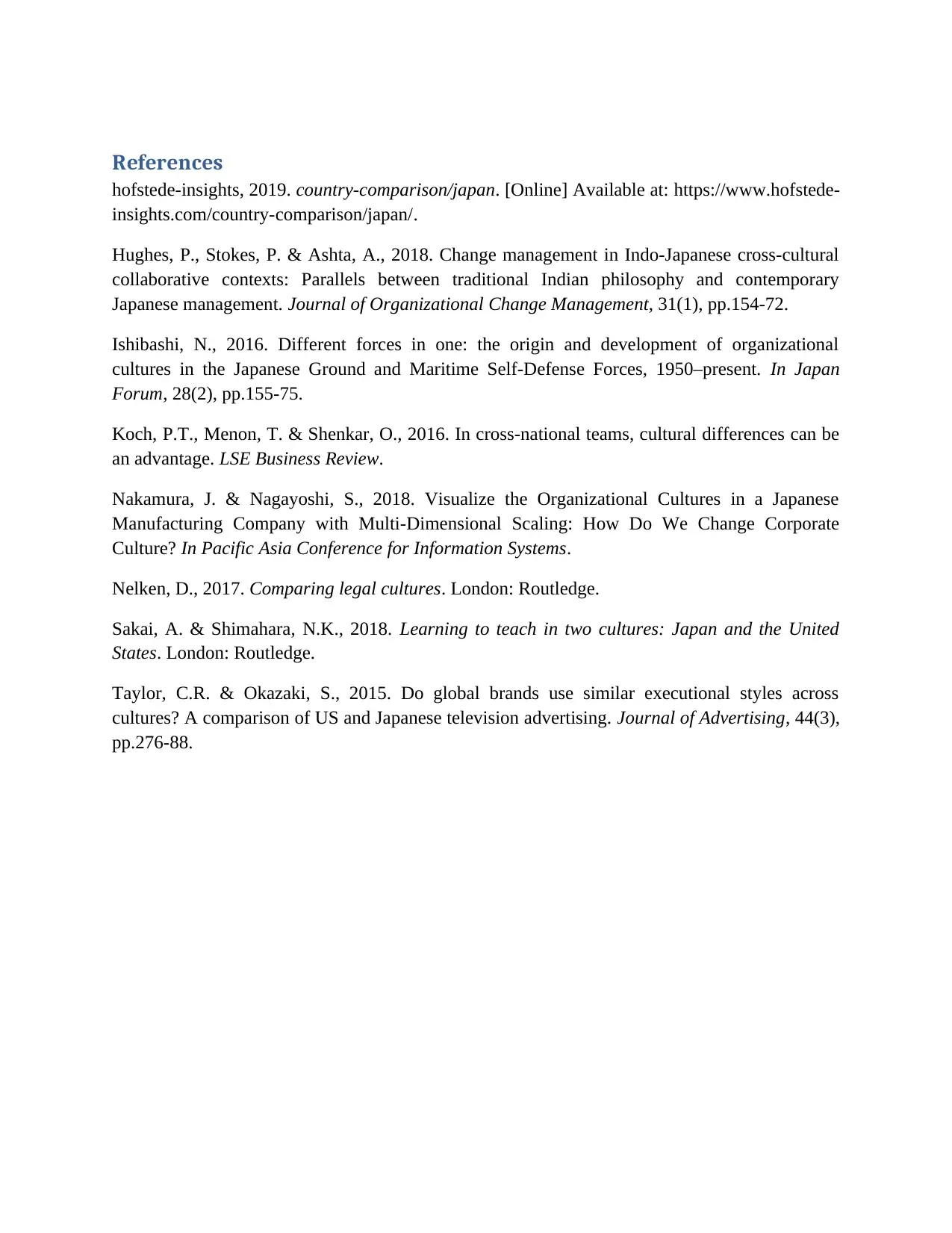
References
hofstede-insights, 2019. country-comparison/japan. [Online] Available at: https://www.hofstede-
insights.com/country-comparison/japan/.
Hughes, P., Stokes, P. & Ashta, A., 2018. Change management in Indo-Japanese cross-cultural
collaborative contexts: Parallels between traditional Indian philosophy and contemporary
Japanese management. Journal of Organizational Change Management, 31(1), pp.154-72.
Ishibashi, N., 2016. Different forces in one: the origin and development of organizational
cultures in the Japanese Ground and Maritime Self-Defense Forces, 1950–present. In Japan
Forum, 28(2), pp.155-75.
Koch, P.T., Menon, T. & Shenkar, O., 2016. In cross-national teams, cultural differences can be
an advantage. LSE Business Review.
Nakamura, J. & Nagayoshi, S., 2018. Visualize the Organizational Cultures in a Japanese
Manufacturing Company with Multi-Dimensional Scaling: How Do We Change Corporate
Culture? In Pacific Asia Conference for Information Systems.
Nelken, D., 2017. Comparing legal cultures. London: Routledge.
Sakai, A. & Shimahara, N.K., 2018. Learning to teach in two cultures: Japan and the United
States. London: Routledge.
Taylor, C.R. & Okazaki, S., 2015. Do global brands use similar executional styles across
cultures? A comparison of US and Japanese television advertising. Journal of Advertising, 44(3),
pp.276-88.
hofstede-insights, 2019. country-comparison/japan. [Online] Available at: https://www.hofstede-
insights.com/country-comparison/japan/.
Hughes, P., Stokes, P. & Ashta, A., 2018. Change management in Indo-Japanese cross-cultural
collaborative contexts: Parallels between traditional Indian philosophy and contemporary
Japanese management. Journal of Organizational Change Management, 31(1), pp.154-72.
Ishibashi, N., 2016. Different forces in one: the origin and development of organizational
cultures in the Japanese Ground and Maritime Self-Defense Forces, 1950–present. In Japan
Forum, 28(2), pp.155-75.
Koch, P.T., Menon, T. & Shenkar, O., 2016. In cross-national teams, cultural differences can be
an advantage. LSE Business Review.
Nakamura, J. & Nagayoshi, S., 2018. Visualize the Organizational Cultures in a Japanese
Manufacturing Company with Multi-Dimensional Scaling: How Do We Change Corporate
Culture? In Pacific Asia Conference for Information Systems.
Nelken, D., 2017. Comparing legal cultures. London: Routledge.
Sakai, A. & Shimahara, N.K., 2018. Learning to teach in two cultures: Japan and the United
States. London: Routledge.
Taylor, C.R. & Okazaki, S., 2015. Do global brands use similar executional styles across
cultures? A comparison of US and Japanese television advertising. Journal of Advertising, 44(3),
pp.276-88.
1 out of 7
Related Documents
Your All-in-One AI-Powered Toolkit for Academic Success.
+13062052269
info@desklib.com
Available 24*7 on WhatsApp / Email
![[object Object]](/_next/static/media/star-bottom.7253800d.svg)
Unlock your academic potential
Copyright © 2020–2025 A2Z Services. All Rights Reserved. Developed and managed by ZUCOL.





